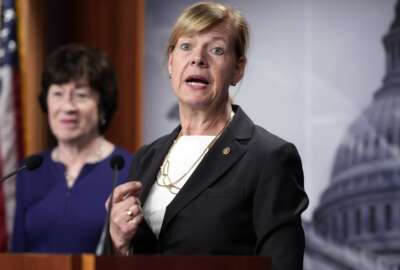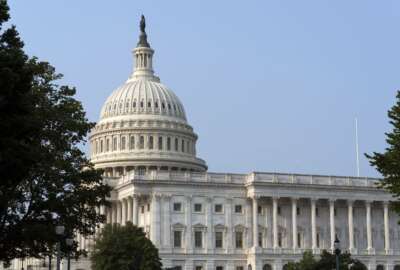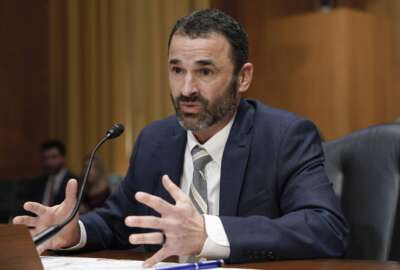Hubbard Radio Washington DC, LLC. All rights reserved. This website is not intended for users located within the European Economic Area.
Part 2: DoD finds clear benefits in aftermath of Goldwater-Nichols
After the passage of the 1986 Goldwater-Nichols Act, the Pentagon stopped fighting the Congressional push for the military services to come together. Instead, i...
wfedstaff | June 4, 2015 2:48 pm
When Congress overhauled the Pentagon’s organizational structure with the Goldwater-Nichols Act 25 years ago, even its strongest backers weren’t sure how well it would work in the real world. But within just a few years, the benefits were clear.
The more than four-year effort to overhaul the Pentagon’s management structure didn’t come with any help from the Pentagon itself. The Joint Chiefs fought the effort every step of the way, accusing Congressional reformers of being unpatriotic and telling them their bill would do severe harm to the military.
But once the reforms were passed and signed by the President, the vitriolic resistance seemed to melt away almost immediately, according to officials who were responsible for passing the bill and implementing its provisions. 
One possible reason for the change in tone — by June of 1987, all of the military service chiefs who had fought the reforms and whose power was reduced by Goldwater-Nichols, had their terms expire and were replaced.
“They didn’t know about the power their predecessors had that we had taken away from them,” Skelton said. “They were now the head of a service that provided warriors to a combatant commander wherever they may be. Prior to that, the Joint Chiefs had a lot to say about how things were conducted during a conflict. We took that and streamlined it under the chairman.”
New reporting structure to the President
Goldwater-Nichols overhauled the Joint Chiefs not just by reducing the influence of the individual military services, but by making the chairman the principal military advisor to the President. That got rid of the consensus-based decision process that critics said yielded “least common denominator” military advice. It also strengthened the role of combatant commanders, then known as “CINCs,” and instilled a culture of jointness between the military services through personnel reforms. Follow-on legislation in 1987 also mandated the instruction of joint doctrine to military service members at war colleges.
James Locher, the former Senate Armed Services staffer whose defense reorganization report laid much of the foundation for Goldwater-Nichols, went on to teach some of those courses. Within a few years of Goldwater-Nichols’ passage, the idea of jointness already was becoming second-nature to young officers, he said.
“Goldwater-Nichols did the broad strokes on moving to jointness,” he said. “But there was lots of innovation inside the Department of Defense. When people kind of understood what was possible, they developed ideas that took this way beyond what anybody could have imagined in 1986.
And just five years after the passage of the act, the reforms in military organization saw their first major real-world test. Operation Desert Storm gave the military its first large-scale wartime experience with a greatly strengthened combatant commander, Gen. Norman Schwarzkopf, and a Chairman of the Joint Chiefs as principal military advisor, Gen. Colin Powell.
“He had come to understand the importance of these particular changes,” Locher said. “For the nation, we were quite fortunate that such a skillful chairman came in at such a pivotal moment. Gen. Powell implemented the ideas fully and we started seeing the benefits of some of the provisions.”
Story continues below timeline. Click here if timeline does not load immediately.
The road to Goldwater-Nichols on Dipity.
Source: Many of the dates in the timeline came from ‘Victory on the Potomac: the Goldwater-Nichols Act unifies the Pentagon’ (2002) by James R.Locher.
Benefits quickly became clear
In 1992, Gen. David Jones, a former Chairman of the Joint Chiefs, found himself before the House Armed Services Committee. Ten years earlier, his testimony before that same committee lit the fuse for the congressional drive to reform the Pentagon. This time, he was being called to examine the outcome of Desert Storm. Jones said he was happy to be able to talk about military success instead of failure.

“Clearly, this was a textbook operation,” he said at the 1992 hearing. “If I rated the before-and-after of Goldwater-Nichols as to how we planned and operated and integrated, before, we were about a three. We’re at about a seven now.”
Jones said without Goldwater-Nichols, Gen. Schwarzkopf, who earned fame as the commander of the swift military campaign, might never have been the leader of Central Command. Before the reform, joint duty assignments weren’t where the military services sent their best and brightest officers. Rather, those jobs were seen as career killers.
Locher said Schwarzkopf and Desert Storm helped to build the importance of those joint assignments in the military services and in the minds of their respective officer corps.
“Officers knew after that that career advancement would be enhanced by going into joint positions and they began to build a joint culture,” he said. “So the implementation of Goldwater-Nichols was a lot smoother that you might have imagined. That’s in part because of key leaders on the military side of the Pentagon.”
Not everything went as planned
But 25 years after Goldwater-Nichols, some reforms haven’t work as well as its drafters may have hoped.
“The procurement reform pieces are still very much a work in progress,” said Rudy deLeon, who served as a deputy secretary of Defense in the Clinton administration.
He also worked for the House Armed Services Committee during the passage and implementation of Goldwater-Nichols. “The act created the position of the undersecretary for acquisition, technology and logistics, and we’ve had some outstanding people move into that job. But there’s a lot more to do,” deLeon said.
At the time Congress passed Goldwater-Nichols, DoD procurement scandals were in the headlines far more than the topic of Defense organization. In the mid-1980s, the Pentagon came under scrutiny for buying $600 toilet seats and $400 hammers. The bill that ended up passing in 1986 incorporated some of the procurement reform remedies recommended by the presidential Packard Commission.
“They wanted to move procurement programs to someone who would manage them full time,” deLeon said. “Prior to that, the military services would manage the procurements and the Pentagon would really only get involved in the research and development phase.” 
“Congress is searching on why Goldwater-Nichols was so successful, and you can see them struggling with those issues when they created the Director of National Intelligence and the Department of Homeland Security,” DeLeon said. “I think there are a lot of models in Goldwater-Nichols that other agencies can learn.”
Locher agreed. After working in the Senate and in the Pentagon, he went on to found the Project on National Security Reform. The group produced a report recommending a Goldwater-Nichols type approach to the rest of the federal government, at least where national security is concerned.
“Our agencies are strapped for resources, and they’re not prepared for the challenges of the 21st century,” Locher said. “But, they need to be able to work together and that’s going to take some major changes in our federal government organization. It’s going to take a transformation.”
A model for other agencies?
Locher said the national security system of 2011 is plagued by two problems: complexity and speed of change. While businesses have tackled those problems by setting up horizontal organizational structures, federal agencies are as vertically oriented as ever, he said.
“We have been dominated by the departments since 1947, and the integrating mechanisms — the National Security Council and its subgroups — are weak by comparison. In the Defense Department, we have the Joint Staff; we have the combatant commands; we have joint task forces and even more subordinate commands that know how to work jointly today,” Locher said. “In the rest of our government, we’ll need the same kinds of changes.”
Locher also said many agencies have national security missions but they aren’t treated that way. He said in too many people’s minds, the national security community still is only made up of the military, diplomats and the intelligence community.
“But in today’s world, national security is the economy, it’s health, it’s trade, and those elements all need to be integrated into the national security system. So there are major changes ahead for our government,” he said.
Locher said he’s not calling for a massive government reorganization. Agency structures can stay as they are, but he thinks the government needs strong integrating forces to bring the full capabilities of agencies together to quickly solve big challenges.
He said in many recent cases, it’s failed to do so: Hurricane Katrina, reconstruction missions in Iraq and Afghanistan, and even the Arab Spring are some of the examples he cites.
And, as in Goldwater-Nichols, employees need to be encouraged and rewarded for working jointly across organizational charts, Locher said.
Skelton agreed. In 2010, together with Rep. Geoff Davis (R-Ky.), he tried to pass a Goldwater-Nichols approach to civilian agencies. The bill got nowhere.
Skelton said prospects for passage of a bold effort like Goldwater-Nichols or his 2010 bill are a lot dimmer in 2011 than they were in 1986.
“It would be a double major challenge to get everybody in line today,” Skelton said. “We had Republicans and Democrats on both sides of the Capitol on board back in 1986. The big thing about this is you’ve got to change the culture, you’ve got to change the way you do business every day. Goldwater-Nichols did that for the military and I think someday we’ll do that for the rest of the government.”
RELATED STORIES:
Part 1: 25 years ago, Goldwater-Nichols united the Pentagon
White House should heed lessons of reorgs past
Bill promotes jointness among national security agencies
Copyright © 2024 Federal News Network. All rights reserved. This website is not intended for users located within the European Economic Area.
Jared Serbu
Jared Serbu is deputy editor of Federal News Network and reports on the Defense Department’s contracting, legislative, workforce and IT issues.
Follow @jserbuWFED





